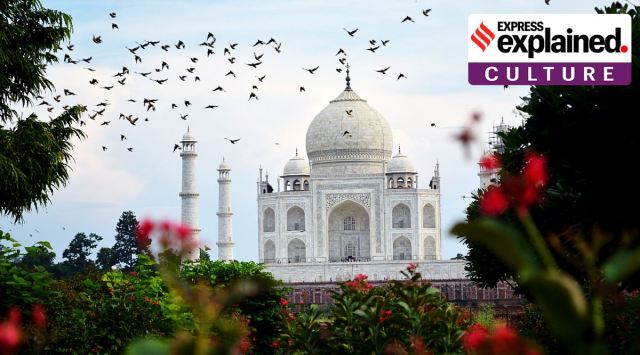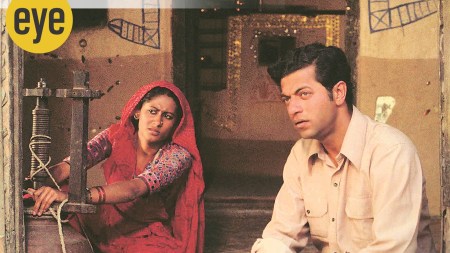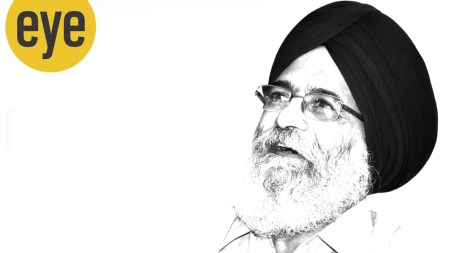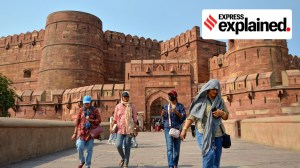- India
- International
Explained: The persistent theory that Taj Mahal was a Hindu temple called ‘Tejo Mahalaya’
Over the years, several BJP leaders have repeated and amplified unhistorical claims that the Taj is in fact a Hindu temple that was built much before the reign of Shah Jahan. A look at the theory of "Tejo Mahalaya".
 Considered one of the Wonders of the World and designated a UNESCO World Heritage Site, the Taj Mahal is a global symbol of India and one of the world's most recognised monuments. (ANI Photo/File)
Considered one of the Wonders of the World and designated a UNESCO World Heritage Site, the Taj Mahal is a global symbol of India and one of the world's most recognised monuments. (ANI Photo/File)Allahabad High Court on Thursday (May 12) dismissed a petition filed by BJP leader Rajneesh Singh asking for a fact-finding panel to establish “the real History of Taj Mahal”, and for more than 20 sealed “rooms” to be opened to look for the possible presence of idols of Hindu gods on the premises of the monument.
A day previously, Diya Kumari, the BJP MP from Rajsamand and a member of the erstwhile royal family of Jaipur, had said that the land on which the Taj stands belonged to her ancestors, and “if there is a need for any documents or anything, we will provide the documents if the court orders so”.
Over the years, several BJP leaders have repeated and amplified unhistorical claims that the Taj is in fact a Hindu temple that was built much before the reign of Shah Jahan. In 2017, Vinay Katiyar, who was then a BJP Rajya Sabha member, claimed that the monument was in fact a Shiva temple named “Tejo Mahalaya”, which was “originally” built by a Hindu ruler.
The “Tejo Mahalaya” claim was first made by a historian named P N Oak in a book written in 1989. He made dogged efforts to establish his idea, and even petitioned the Supreme Court, which is said to have commented in 2000 that he had a “bee in his bonnet”.
The Taj Mahal
Considered one of the Wonders of the World and designated a UNESCO World Heritage Site, the Taj Mahal is a global symbol of India and one of the world’s most recognised monuments. It was built between 1632 and 1648 on the orders of the Mughal Emperor Shah Jahan.

The Taj incorporates characteristics of Indo-Islamic and Timurid architecture, and is often seen as a natural progression of Mughal architecture from older monuments such as Humayun’s Tomb in Delhi.
The immense white marble mausoleum is set in a garden that is part of a larger complex built along a series of geometrical grids enclosed within walls that measure 305 metres by 549 metres. The complex was completed in 1653 after structures such as a mosque, a guest house, the main gateway, and the outer courtyard were built.
The breathtakingly beautiful monument is the burial place of Shah Jahan’s beloved wife Mumtaz Mahal. Shah Jahan himself was subsequently interred there. Although renowned as an immortal symbol of love, historians have argued that it was possibly more a monument to Shah Jahan’s ambition than to his love for Mumtaz, and a declaration of the power and glory of the Mughal empire. “…The Taj Mahal was built with posterity in mind,” wrote the art historian Ebba Koch.
The exterior of the mausoleum is adorned with calligraphy of Quranic verses, which are inlaid on rectangular panels. There are minarets at the four corners of the platform on which the mausoleum stands.
To the south of the tomb is the garden that is divided into quadrants by waterways, which according to Catherine Asher, a historian of Islamic and Indian art, resemble the streams of paradise mentioned in the Quran. According to Asher, the garden was modelled on the ancient Persian concept of the garden of paradise, which the Mughals adopted.
The theory of “Tejo Mahalaya”
P N Oak, the writer and founder of the Institute for Rewriting Indian History, believed that monuments attributed to Muslim rulers were actually Hindu in origin. In 1976, he wrote a book called ‘Lucknow’s Imambaras are Hindu Palaces’, and another titled ‘Delhi’s Red Fort is Hindu Lalkot’. In 1996, he published ‘Islamic Havoc in Indian History’.
However it was Oak’s 1989 book, ‘Taj Mahal: The True Story’ that continues to shape present-day controversies surrounding the Taj Mahal. Oak argued that Shah Jahan’s Taj was in fact a Hindu temple to Lord Shiva that was “perhaps built in the 4th century to serve as a palace” by one Raja Paramardi Dev.
According to Oak, not only was the Taj built centuries before the arrival of the Mughals, “Our research has firmly established that the term Taj Mahal is a popular mispronunciation of the ancient Hindu name Tejomahalaya.”
He theorised that “Tejo Mahalaya” was destroyed and raided during Muhammad Ghori’s invasion of India in the late 12th century, and that after the defeat of Humayun (mid-16th century) it passed into the hands of the Jaipur royal family and was managed by Jai Singh I, who was a senior Mughal mansabdar and the Raja of Amber.
According to Oak, the temple was then taken over by Shah Jahan, who turned it into a tomb and renamed it Taj Mahal.
Oak moved the Supreme Court “to reestablish the truth and cultural heritage of our country”, but made no headway. A PTI report from 2000 says the court dismissed the petition as “misconceived”. “Somebody has a bee in his bonnet, hence this petition,” was the remark of a Division Bench comprising Justices S P Bharucha and Ruma Pal, the PTI report said.
But Oak’s theory lived on
Long before the Allahabad High Court petitioner Rajneesh Singh, Oak had demanded the opening of the “sealed chambers” of the Taj. “It is my feeling that some very decisive evidence lies hidden in those sealed chambers. They could contain Sanskrit inscriptions, Hindu idols, scriptures and coins laying bare the pre-Shahjahan history of that building,” he wrote.
Singh’s petition in the High Court repeated Oak’s theory, according to a report in the law portal Live Law. “It is there in many History books that in 1212 AD, Raja Paramardi Dev had built Tejo Mahalaya temple palace (presently Taj Mahal). The temple was later inherited by Raja Maan Singh, the then Maharaja of Jaipur. After him, the property was held and managed by Raja Jai Singh but was annexed by Shah Jahan (in 1632) and later it was converted into memorial for the wife of Shah Jahan,” the Live Law report quoted the petition as saying.
Newsletter | Click to get the day’s best explainers in your inbox
A similar petition had been filed in a district court in Agra in 2015. The petitioners had claimed that the Taj Mahal was a Hindu temple, and thus the government should allow Hindus to perform “darshan” and “aarti” in the temple.
While Oak’s theory about the Hindu temple has no historical basis, some historians have said that the land on which the Taj stands was indeed originally under the control of the Jaipur royals. This piece of land by the Yamuna, across the river from the Agra fort which was used (and expanded) by Akbar (and by other dynasties before the Mughals), was requisitioned from Jai Singh, who was duly compensated by Shah Jahan.
More Explained
EXPRESS OPINION
May 19: Latest News
- 01
- 02
- 03
- 04
- 05








































